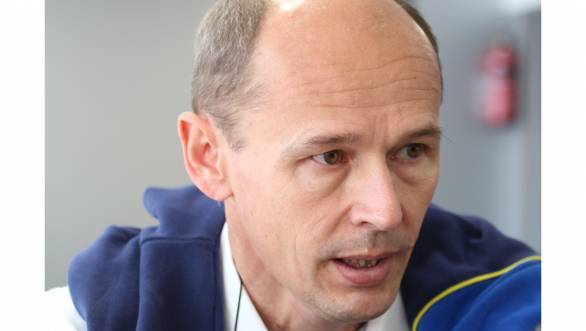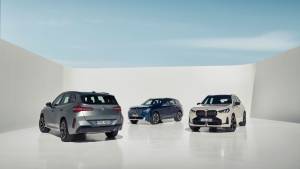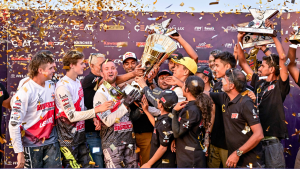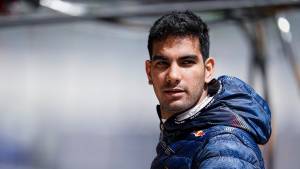Interview: Nicolas Goubert on Michelin's role in MotoGP
At the recently concluded MotoGP race at Catalunya, we had a chance to sit down with Nicolas Goubert, Michelin's Deputy Director, Technical Director and Supervisor of Michelin's MotoGP Programme, and discuss all things tyres. Here is what he had to say.
 Nicolas Goubert, Supervisor of Michelin's MotoGP Programme in conversation with us at the MotoGP round at Catalunya
Nicolas Goubert, Supervisor of Michelin's MotoGP Programme in conversation with us at the MotoGP round at Catalunya
On why Michelin goes racing
Nicolas Goubert: There are two reasons for Michelin is in racing. The first one being for the brand image and the other one is to develop technology. We think it's a very good proving ground to develop technology - you have the best riders in the world, your best engineers working on the bike, on the car when it's a car. So, it's a very good place where you get great feedback from the field and it allows you to develop very fast. When we prepare tyres for the race, we prepare two weeks ago, maybe we know tonight if we do a good job or not.
And just to give you an example what sort of technology transfer in the past from the track to the street in motorbikes. For example we developed radial tyres. Radials are something Michelin developed 60 or 70 years ago for cars but actually for bikes it's more recent. And we develop technology in for example the 500 series in the early '80s with riders like Randy Mamola. In '83 we used them in the season and we put on the market the first motorcycle radial tyres in '85. The second example is the silica. Silica is something we use now in all tyres of motorcycle, car tyres and all our competitors do as well. But the first time anyone used Silica was in racing in the wet in Suzuka. And we transferred that not only to bike tyres but also to car tyres. Third one, more recently it's something we did at the beginning of the MotoGP era. As you might know we have been involved in motorcycle racing for maybe 30 years from the 70s to 2007. When the series started in 2002 going from 500 to MotoGP, we started making for every race new compounds for the rear tyres with different compounds for different parts of the tyres. Different track layouts are always asymmetric. So it isn't the same strain on each side of the tyre. And it's very different again on the centre of the tyre. So we started using that every race from 2002. In 2004-5, I don't remember, we produced the first mass production sport bike tyre Pilot Power 2CT - 2 compound technology.
So there are real examples you know where we learnt from the tracks to give to our customers later on the same kind of technology. Now how long it takes us to transfer technology depends on the industrial tuning we need. When we do for small series like here we have to adapt. But when we make for regular production the plans are much more precise so... I would say average for the examples I gave you is between 2 and 4 years. When it is something easier can be quicker. But quite often there is some industrial modification required so that's why it takes 2-3 years. Something I cannot tell you is what will be the next breakthrough.
On Michelin's biggest challenge in MotoGP
NG: The biggest challenge was to give confidence to riders with the new tyres because most of these guys have not been riding on the previous tyres for years and years and so it's a big change when you change tyres. So you have issues. We had issues at the beginning to find the right compromise between the bike setup, the tyre evolution and the way people ride. I think we have evolved quite a lot from the beginning. But they did changes to the setup, for sure changes to the way they ride. Maybe not drastically because you cannot change one day to the other. And now they are getting more and more confidence. But that was the biggest thing. To find how to give them confidence to ride at the maximum.
On the difference between their various racing compounds
NG: At the rear it changes quite a lot because we have very different layouts. For example a very famous track for motorcycle is the Phillip Island, where for along time you have the bike on the side a lot of speed, a lot of acceleration. Lot of strain on the left side of the tyre. The compound we have there is very different. Quite a big difference. What we can (use as) the hard here, could be the soft at some other circuit.
On Colin Edwards as their test rider and on rider feedback
NG: So first thing. Rider feedback is key. Because although we have the simulation tools at the end of the day only the rider can give you an assessment of the performance of the tyre. It's like when you work on a new wine or drink or type of food. Basically if it doesn't appeal to the customer it doesn't matter how good it is. So it's very very important.
To come back to MotoGP, of course, we started testing with some riders and Colin was one of them for Yamaha. And when Yamaha ask us if we will be happy to take Colin as test rider we are like that's great because not every rider is capable of describing exactly what is happening and translating that in a good way, in a listenable way for the engineers to work on it. Some people are gifted for that and some people are less gifted. Colin is very gifted and not only he can describe you what's happening but he knows as well what's good for his guys. That's very important. Very often most of the riders can tell you what is good for them. He can tell you what is good for the others. Because he knows them very well, he raced with them for many years. So he knows the way they ride. He's got a different way of riding and quite often he told us okay that I like, but that won't work for them. Or that that I am not very keen on, but they will like this. So that's very important.
Now how we collect information. We have a group of 7 technician who are following the series - all testing, all the races. They are listening every time the riders come back to the pits and make an assessment of the performance of the bike setup and the tyres. We listed to what he says and of course we keep all this information and try to come back with a summary of the "percentages" of the weekend, what we have to improve and we start from the riders comments. Everything starts from the riders comments.
On the motivation to continue as control tyre in MotoGP and on branching out to other series
NG: For the first year no problem to keep the motivation very high. Because it is a learning year. Even though we have been in this series for 30 years we were out for seven years. Seven years is a long time. Things change, the tracks even sometimes change. And the bikes have changed quite a lot.
So the first year, every weekend is a new learning process but afterwards and you know that happens in the other series as well for example we in the World Rally Championship where we don't have any competitors so we set up targets for us. We say okay we have to improve for example by three-tenth of a second a lap in the second year and keep working towards that target till we get it. So we will not stop... you know sometimes our competitors when they are the only ones they keep the same tyres years after years after years but we are not here for that. you know because if we cannot use this proving ground for our technology we will stop. So we fix internal targets to keep the motivation high.
On bidding to be control tyre for F1 in the future
NG: Right now, we're very happy with the series we are participating in. Since 2011, we started getting into WEC, Electric Formula (Formula E), MotoGP now. We got a wide coverage and a different area where we can work on the different kind of tyres. For example, in electric formula you can work on the efficiency of the tyres trying to keep the highest rate possible. In the WEC, we work in the puncture resistance of the tyres which is very very important for the emerging market, like India, China and so on. Here [MotoGP] we work on the grip. In Formula 1, if they stay with the 13 inch tyre, we are not interested. We develop this technology... this is 50 years old technology. It would make things really difficult to transfer tyre technology from the 13 inch to 18,19,20 inch.
On the goal of doubling the tyre life in Formula E's second season
NG: That's not happening. Basically, there was not a consensus among the organiser, the FIA, the teams. To go in that direction so we're not doing. We could have done it...
On continuing their association with the WRC past 2016
NG: We're working now to you know try to adapt the tyres to new regulations. As you know it's a big, big change. Just to give you some numbers, the engine output is going to go from roughly 320hp to around 400. It's a big change. So, we have to adapt our tyres. We are working on that. We are working on that with the organiser and we want to find, I mean because our contract ends up end of this year, so with the new series coming, we're talking to them. I don't know what will happen and we are willing to continue.
On the visual presentation of tyres and the possibility of changing from black to other colours
NG: Tyres have not always been black. Actually, if you remember there were whitewalls and white tyres in the beginning. One stage we did some tyres with colours in the tread area as well. It was for the World Cup in Brazil we sold few thousand of the tyres with Brazilian colours. And with our BF Goodrich brand as well one stage maybe 8-10 years you could you had the choice to decide yourself the choice of three different colours you could pick up the colours you wanted to have in your tyres. But we didn't pursue the ideas because basically the reaction of the market was not that great. And we didn't think it was the right direction to go to.
On compound deployment for various parts of the tyre
Basically you can get you know if you ask something of the tyres, traction or lateral grip, it cannot give you everything at the same time. So for example at the apex basically you want to have the maximum lateral force. Ok so you don't want to ask any traction or longitudinal force or braking - no gas and no brake. Gradually when you pick up the bike you can gradually open the throttle. And the less lateral force you will ask the tyres the more longitudinal force you get back. Of course that's why the compounds... Right now we have the same compounds all the way to the side. At one stage we try to tune different compounds right at the edge, mid-center we try to maximise both but that was very tricky because you can change very quickly on a given track so we dropped the idea. So I would say it is a more physical aspect of the tyre than a chemical aspect.
On the Tweel Airless Tyre
(It's for) softer application like lawnmower and all we launched last year in the US. Not yet (being used for motorcycles). We have had an airless tyre for off-road use for years and year. Have you heard of Bib Mousse? We don't have air in that tyre. We have never tried (for motorcycles) actually. Right now it's very complicated we have to do step by step. We cannot try everything at the same time.














